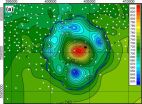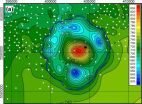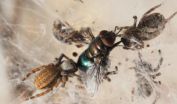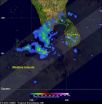(Press-News.org) EDMONTON—The discovery of an ancient ring-like structure in southern Alberta suggests the area was struck by a meteorite large enough to leave an eight-kilometre-wide crater, producing an explosion strong enough to destroy present-day Calgary, say researchers from the Alberta Geological Survey and University of Alberta.
The first hints about the impact site near the southern Alberta hamlet of Bow City were discovered by a geologist with the Alberta Geological Survey and studied by a U of A team led by Doug Schmitt, Canada Research Chair in Rock Physics.
Time and glaciers have buried and eroded much of the evidence, making it impossible at this point to say with full certainty the ring-like structure was caused by a meteorite impact, but that's what seismic and geological evidence strongly suggests, said Schmitt, a professor in the Faculty of Science and co-author of a new paper about the discovery.
"We know that the impact occurred within the last 70 million years, and in that time about 1.5 km of sediment has been eroded. That makes it really hard to pin down and actually date the impact."
Erosion has worn away all but the "roots" of the crater, leaving a semicircular depression eight kilometres across with a central peak. Schmitt says that when it formed, the crater likely reached a depth of 1.6 to 2.4 km—the kind of impact his graduate student Wei Xie calculated would have had devastating consequences for life in the area.
"An impact of this magnitude would kill everything for quite a distance," he said. "If it happened today, Calgary (200 km to the northwest) would be completely fried and in Edmonton (500 km northwest), every window would have been blown out. Something of that size, throwing that much debris in the air, potentially would have global consequences; there could have been ramifications for decades."
The impact site was first discovered in 2009 by geologist Paul Glombick, who at the time was working on a geological map of the area for the Alberta Geological Survey. Glombick relied on existing geophysical log data from the oil and gas industry when he discovered a bowl-shaped structure.
The Alberta Geological Survey contacted the U of A and Schmitt to explore further, peeking into the earth by analyzing seismic data donated by industry. Schmitt's student, Todd Brown, later confirmed a crater-like structure.
INFORMATION:
The research team's paper about the discovery was published in the journal Meteoritics & Planetary Science in an early online release.
Ancient crater points to massive meteorite strike
2014-05-07
ELSE PRESS RELEASES FROM THIS DATE:
Mapping the spider genome
2014-05-07
The fact that the eight-legged creepy spider in some ways resembles humans is one of the surprising conclusions after researchers at Aarhus University and the Beijing Genomics Institute (BGI) succeeded in sequencing its genome.
However, it is more a discovery on an awesome scale. The sequencing has far greater significance for our future understanding of the spider's special properties.
"In brief, we've acquired a tool for everyone interested in spiders," say Kristian W. Sanggaard and Jesper S. Bechsgaard, Aarhus University. Together with Xiaodong Fang, BGI, they are ...
Neural states affect learning
2014-05-07
Theta-band activity in hippocampus after an event seems to be crucial for learning. A study at the University of Jyväskylä also proved that the absence of theta facilitated learning a simple task while training during theta had no effect on learning.
Hippocampus is a brain structure that has a critical role in mammalian learning. The identification of different hippocampal states is based on the oscillatory properties of electrophysiological activity. Traditionally, rhythmic slow activity, theta, has been linked to attention, whereas transient bursts of synchronised neuronal ...
Third US National Climate Assessment reports our ecosystems are already changing
2014-05-07
The US Global Change Research Program released its Third National Climate Assessment (NCA) of the impacts of climate change on biodiversity and ecosystems this Tuesday, May 6. The NCA is the most comprehensive peer-reviewed analysis of climate change's impacts in the United States, informing Americans about the effects of climate change in their backyards.
"As an ecologist, you can't escape the effects of climate change on natural resources. We're observing climate impacts in nearly all natural and managed ecosystems," said Ecological Society of America President Jill ...
Breastfeeding promotes the growth of beneficial bacteria in the gut
2014-05-07
A number of studies have shown that breastfed babies grow slightly slower and are slightly slimmer than children who are fed with infant formula. Children who are breastfed also have a slightly lower incidence of obesity, allergies, diabetes and inflammatory bowel disease later in life. According to a new study by the National Food Institute and the University of Copenhagen this may be due to the fact that breastfeeding promotes the development of beneficial bacteria in the baby's gut.
"We have become increasingly aware of how crucially important a healthy gut microbial ...
Nanoscale heat flow predictions
2014-05-07
Physicists are now designing novel materials with physical properties tailored to meet specific energy consumption needs. Before these so-called materials-by-design can be applied, it is essential to understand their characteristics, such as heat flow. Now, a team of Italian physicists has developed a predictive theoretical model for heat flux in these materials, using atom-scale calculations. The research, carried out by Claudio Melis and colleagues from the University of Cagliary, Italy, is published in EPJ B. Their findings could have implications for optimising the ...
Researchers use DNA to build tool that may literally shine light on cancer
2014-05-07
Bioengineers at the University of Rome Tor Vergata and the University of Montreal have used DNA to develop a tool that detects and reacts to chemical changes caused by cancer cells and that may one day be used to deliver drugs to tumor cells.
The researchers' nanosensor measures pH variations at the nanoscale – how acidic (a higher pH level) or alkaline (a lower pH level) it is. Many biomolecules, such as enzymes and proteins, are strongly regulated by small pH changes. These changes affect in turn biological activities such as enzyme catalysis, protein assembly, membrane ...
Sleep researchers at SRI International identify promising new treatment for narcolepsy
2014-05-07
MENLO PARK, Calif.—May 7, 2014—Neuroscientists at SRI International have found that a form of baclofen, a drug used to treat muscle spasticity, works better at treating narcolepsy than the best drug currently available when tested in mice.
According to the National Institute of Neurological Disorders and Stroke (NINDS), narcolepsy, a chronic neurologic disorder characterized by excessive daytime sleepiness, is not a rare condition, but is under-recognized and under-diagnosed. It is estimated to impact 1 in 2,000 people worldwide.
In back-to-back papers published in ...
Argentina yields 3 new tarantula species
2014-05-07
A team of scientists from the Universidad de La República, Uruguay discovered three native to northern Argentina new species of the engaging spider group of the tarantulas. The study describing the newly found tarantulas was published in the open access journal ZooKeys.
The often hairy and very large spiders known as tarantulas are one of the most famous arachnid groups. Despite their ill fame as vicious killers most tarantulas are harmless to humans. Most tarantulas long lifespans, females can live between 15 and 30 years, which makes them a preferred pet for spider ...
A hydrogel that knows when to go
2014-05-07
HOUSTON – (May 7, 2014) – Rice University bioengineers have created a hydrogel that instantly turns from liquid to semisolid at close to body temperature – and then degrades at precisely the right pace.
The gel shows potential as a bioscaffold to support the regrowth of bone and other three-dimensional tissues in a patient's body using the patient's own cells to seed the process.
The hydrogel created in the lab of Rice bioengineer Antonios Mikos is a liquid at room temperature but, when injected into a patient, becomes a gel that would fill and stabilize a space while ...
NASA sees system 91B making landfall in southwestern India
2014-05-07
A tropical low was affecting southern India and Sri Lanka on May 6 at 0809 UTC when the Tropical Rainfall Measuring Mission satellite called TRMM flew above it. By May 7, System 91B moved over southwestern India and became less organized.
TRMM's Precipitation Radar revealed that rain was falling at a rate of 66 mm (2.6 inches) per hour in the stormy area south of India (5.2 north latitude and 77.1 east longitude). TRMM PR saw the tallest thunderstorm towers over Sri Lanka where heights were pushing to altitudes above 13 km (8 miles).
On May 7 at 12:30 UTC/8:30 a.m. ...






